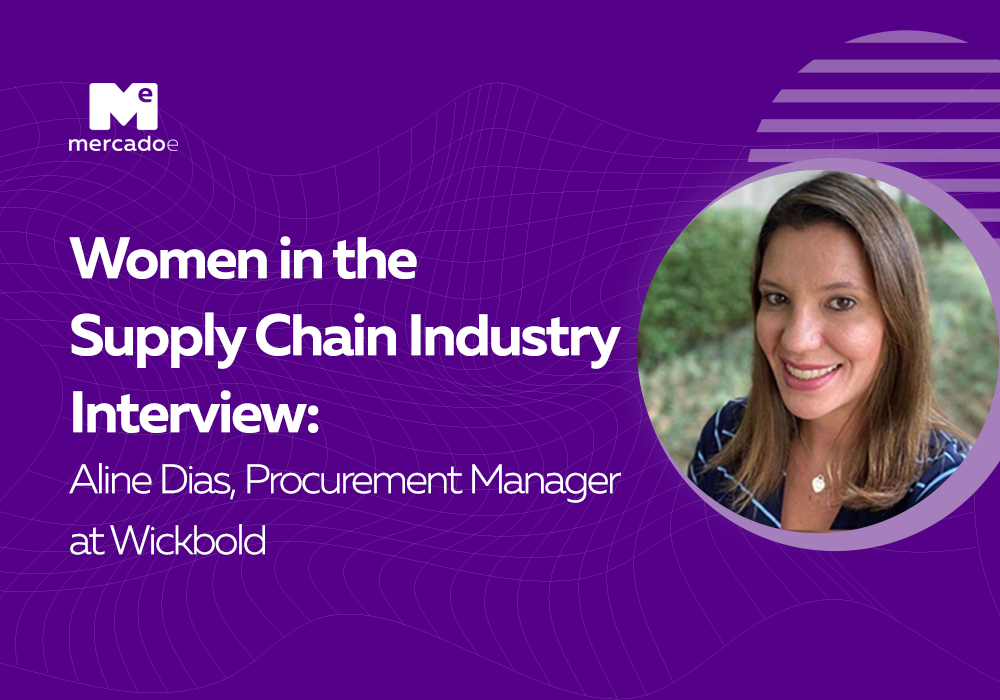
The ME Women in Supply Chain Special is just getting started. We invited Aline Dias, Procurement Manager at Wickbold, to talk about her career, achievements, and main challenges in the industry. With 17 years of experience in the field, the executive answered various questions, such as what were the biggest learnings as a procurement manager and what technologies were adopted to innovate and adapt to different scenarios and transformations.
Learn more about the career of Aline Dias, Purchasing Manager at Wickbold
Get to know Aline Dias’ trajectory, Procurement Manager at Wickbold. With 17 years of experience in the field, Aline has solid knowledge in Strategic Sourcing, categorization, negotiation strategy definition, and project management focused on cost reduction. Additionally, she works with a focus on process improvement, risk mitigation in contracting and compliance, and building partnerships with leaders from all areas.
Check out the questions and answers from the interview:
1. Could you tell us a little about your trajectory, and how did your interest in a career in Procurement arise?
A: I usually joke that people “fall” into procurement, and that was how it happened to me too. At the beginning of my career, still as an intern, I was invited to work in the field. It was love at first sight! In procurement, we don’t have a routine. We have the possibility of learning about different niches, such as service contracting, parts and equipment procurement, packaging, and, of course, the heart of the industry: raw materials, each with its particularity and need.
2. Throughout your career, you have worked for major companies such as Bunge, Saint-Gobain, and Wickbold. What were the biggest lessons you learned from working in the procurement departments of these global companies?
A: It is very important to be close to the internal client, to understand the production process, their challenges, and how to improve processes to deliver results beyond financial gains. Asking for feedback about the procurement department is crucial, as well as showing other areas the size and importance of the department. During my work experience, I have noticed that internal clients often lack knowledge about what we do, but when we demonstrate our performance with numbers, everyone is surprised. It is up to the procurement professionals to sensitize internal clients.
3. A study conducted by Harvard Business Review found that companies that invest in actions aimed at increasing diversity, at all levels of the organization, have a 45% higher chance of increasing their market share. But this is just one of the advantages that a diverse environment can bring to organizations. In your opinion, what other benefits can be brought by investing in more diverse teams?
A: Investing in a diverse team brings knowledge at all levels. There are different perspectives on how to act and in different areas, in addition to the possibility of having profiles that are suitable according to the internal customer and their needs.
4. What characteristics of female leadership do you believe can bring positive impacts to the Supply Chain sector?
A: Female leadership has more resilience and dedication, especially with regards to communication, which is essential in the Procurement area. We, professionals in this area, need to listen, understand, and weigh several aspects and scenarios for a good decision-making process.
5. Do you have any female leadership reference that you looked up to throughout your career? Do you see yourself as a reference for other female professionals in Supply Chain?
A: Yes, my current manager, Keila Gobbi, and my former manager when I was at J Macedo, Luciana Cicolo, are people who have inspired me until now. I have been told that I am a reference for people on my team and for those who I have led in the past. They come to me to exchange experiences. This recognition is very gratifying.
A: At Wickbold, ESG is taken very seriously. We have several sustainability initiatives in the company and prioritize this agenda in all our negotiations. In RFIs, we ask how companies are progressing with this agenda. We are also implementing a supplier evaluation program that will have an ESG pillar, as well as a supplier management policy that will also address these issues.
A: I think technology helps us improve processes, especially more operational tasks. Most organizations are still structuring themselves to implement processes, just like Wickbold. Currently, we are working to implement KPIs, via Power BI, and RPA for some purchasing activities.
8. With the constant changes brought about by new technologies and an uncertain market scenario, purchasing professionals have had to develop new skills to remain relevant. In your opinion, what are the essential skills for the procurement professional of the future?
A: Seeing beyond the financial aspect, trying to anticipate business needs to bring solutions and developments of new supply options, not only focused on cost avoidance or saving, but to add technology and innovation to the production process.
9. Thinking about the future, how do you see the Supply Chain sector in a few years? What competencies do you believe a procurement professional needs to develop to remain relevant in this new scenario?
A: I believe that the supply chain professional needs to be open to technology, develop strategic activities, explore new market options. And to be more competitive, it is also important to seek to anticipate what competitors in your segment are doing. This includes adding technology, developing suppliers, and the global supply market of low-cost countries.
10. Finally, what advice would you give to other professionals who want to build a long-term career in the Supply Chain sector?
A: For a successful career in purchasing, it is essential to have resilience, persistence, and focus. We have many opportunities in the area, and there is always something new and different to be done. Do not be afraid to dare; sometimes, bold ideas can lead to significant business opportunities.


 Português do Brasil
Português do Brasil Español
Español Português
Português
